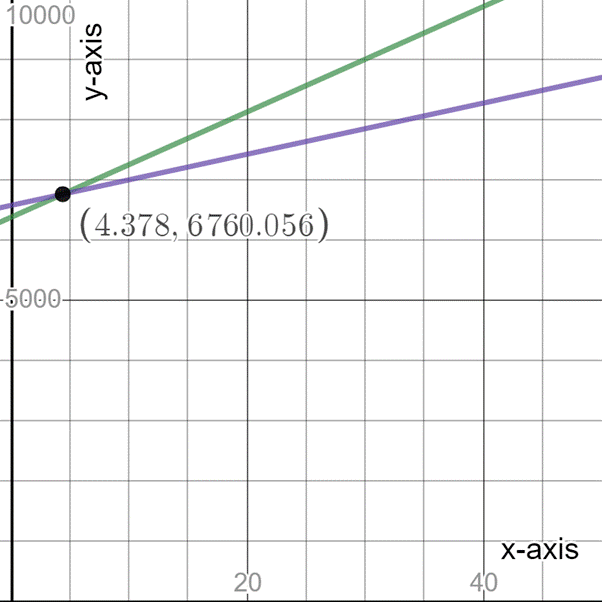
Concept explainers
(a)
To Find: To find the population of the two given states and draw the table for each.
(a)
Explanation of Solution
Given information:Modelled of the two states
Calculation:
Population in the year 2010, when
Population in the year 2011, when
Population in the year 2012, when
Population in the year 2013, when
Population in the year 2014, when
Population in the year 2015, when
Population in the year 2016, when
Population in the year 2017, when
| Year | Arizona | Massachusetts |
| 2010 | 6377 | 6574 |
| 2011 | 6464.5 | 6616.5 |
| 2012 | 6552 | 6659 |
| 2013 | 6639.5 | 6701.5 |
| 2014 | 6727 | 6744 |
| 2015 | 6814.5 | 6786.5 |
| 2016 | 6902 | 6829 |
| 2017 | 6989.5 | 6871.5 |
(b)
To find: To find the year(s) in which the population of Arizona is greater than the Massachusetts.
(b)
Answer to Problem 89E
The years are 2015, 2016 and 2017.
Explanation of Solution
Given information:Given table
| Year | Arizona | Massachusetts |
| 2010 | 6377 | 6574 |
| 2011 | 6464.5 | 6616.5 |
| 2012 | 6552 | 6659 |
| 2013 | 6639.5 | 6701.5 |
| 2014 | 6727 | 6744 |
| 2015 | 6814.5 | 6786.5 |
| 2016 | 6902 | 6829 |
| 2017 | 6989.5 | 6871.5 |
From the table, it can be seen that from 2010 to 2014 the population of Arizona is less than the population of Massachusetts. But afterwards, in the year 2015, 2016 and 2017 the population of Arizona is greater than the Massachusetts.
Hence the population is greater in the year of 2015, 2016 and 2017.
(c)
To Graph: Tograph the given model functions.
(c)
Explanation of Solution
Given information:Given model function
Graph:

Interpretation:
In the graph the x-axis shows the time t and y-axis shows the population. The green line represents the population of Arizona and the blue line represent the population of Massachusetts.
(d)
To Find: To find the solutions of the given model functions.
(d)
Answer to Problem 89E
The answer is
Explanation of Solution
Given information:Given model function
Formula used: Substitution method
Calculation:
The point of intersection find out when
Thus, when t is 4.377 the population of both the states are equal that is
Hence the point of intersection is
Chapter 7 Solutions
PRECALCULUS W/LIMITS:GRAPH.APPROACH(HS)
 Calculus: Early TranscendentalsCalculusISBN:9781285741550Author:James StewartPublisher:Cengage Learning
Calculus: Early TranscendentalsCalculusISBN:9781285741550Author:James StewartPublisher:Cengage Learning Thomas' Calculus (14th Edition)CalculusISBN:9780134438986Author:Joel R. Hass, Christopher E. Heil, Maurice D. WeirPublisher:PEARSON
Thomas' Calculus (14th Edition)CalculusISBN:9780134438986Author:Joel R. Hass, Christopher E. Heil, Maurice D. WeirPublisher:PEARSON Calculus: Early Transcendentals (3rd Edition)CalculusISBN:9780134763644Author:William L. Briggs, Lyle Cochran, Bernard Gillett, Eric SchulzPublisher:PEARSON
Calculus: Early Transcendentals (3rd Edition)CalculusISBN:9780134763644Author:William L. Briggs, Lyle Cochran, Bernard Gillett, Eric SchulzPublisher:PEARSON Calculus: Early TranscendentalsCalculusISBN:9781319050740Author:Jon Rogawski, Colin Adams, Robert FranzosaPublisher:W. H. Freeman
Calculus: Early TranscendentalsCalculusISBN:9781319050740Author:Jon Rogawski, Colin Adams, Robert FranzosaPublisher:W. H. Freeman
 Calculus: Early Transcendental FunctionsCalculusISBN:9781337552516Author:Ron Larson, Bruce H. EdwardsPublisher:Cengage Learning
Calculus: Early Transcendental FunctionsCalculusISBN:9781337552516Author:Ron Larson, Bruce H. EdwardsPublisher:Cengage Learning





